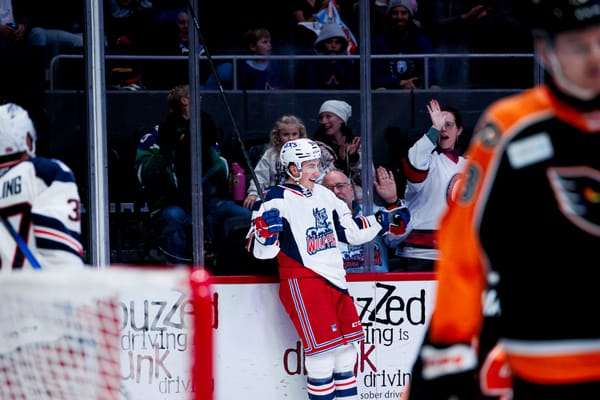2019 Report Card: Marc Staal
The 2018-19 campaign was another down year for the veteran blueliner.
Marc Staal was made the defacto captain going into the season. Without Ryan McDonagh, Dan Girardi, and Derek Stepan, plus the looming Mats Zuccarello trade that seemed inevitable, Staal was one of the few remaining pieces of the New York Rangers’ core besides Henrik Lundqvist.
Whether he deserved to be based on his play, and not his veteran status, is another story. His 2017-18 season was better than 2016-17, but then again, the expectations were so low to begin with considering his decline.
Going into 2018-19, between his supposed improvement and redemption, paired with his veteran status on a rebuilding team, Staal appeared to be destined for a role in the Rangers’ top four. Once again, the results were expectedly bad.
Raw Stats
Staal appeared in 79 games — the most of all Blueshirt defenders — and his absences were related to injury or illness. He scored three goals and registered a helper on 10 others for a whopping 13 points, which was an improvement on the eight points he tallied in 2017-18. He also averaged 19:25 a game in all situations which was up from 18:32 last season.
Fancy Stats
Staal was either the Rangers’ worst, second-worst, or third-worst rear guard in relevant statistical measures, but that didn’t stop him from logging the second-most minutes (1260) in 5v5 situations.
At no point during the season did coach David Quinn scratch Staal for performance reasons, and that’s something that has to change next season if he remains with the club.
Staal’s shortcomings include: a CF% of 43.15 (worst), a Rel CF% of -3.97 (second-worst), a GF% of 42.45 (third-worst), a Rel GF% of -5.02 (second-worst), an xGF% of 45.61 (second-worst), and a Rel xGF% of -1.77 (third-worst).
For reference, here’s how Staal fared in each category last year
- CF%: 43.66 (second-worst) | Rel CF%: -2.77 (second-worst)
- GF%: 51.25 (Second-best) | Rel GF%: 6.32 (third-best)
- xGF%: 49.01 (second-best) | Rel xGF%: -1.36 (fourth-best)/
The Rangers’ defense was a clear weakness both this and last season, but under Quinn the team did make some improvements — Staal’s underlying numbers just don’t reflect it. Some of that could be explained by how he’s continued to slow as he’s aged, the defensive struggles under assistant coach Lindy Ruff, and the mismatched pair he spent much of the season in with Neal Pionk.
Deployment
Here are the most popular pairs Staal was a part of this season.
Staal was clearly given more minutes than deserved, and Quinn and Ruff kept him with Pionk for far too long. In fact, the duo ended the season as one of the worst pairings in the NHL. Neither drove play enough to push the pace of play, and neither proved to be a strong enough defender to make up for the other’s weaknesses.
The pairing spent 667:43 together, and put up some horrid results. This season 55 defense pairs logged at least 500 minutes together, and this is where Pionk and Staal were ranked in the relevant categories.
Collectively the unit was bad, but how did each look individually away from their respective partner?
This chart tells an interesting story, and when you look at the PDO column it reinforces that the results weren’t heavily impacted by good or bad luck. The results speak for themselves, and it’s telling that both saw an uptick expected goals when away from each other.
Additionally, the poor possession numbers explain the .908 SV%, vs. a .917 SV% when Pionk was away from Staal, and a .919 SV% when Staal was away from Pionk. There’s a greater chance the puck will end up in the back of their own net instead of the opponent’s when the puck’s mismanaged, and that was a key theme of the Staal-Pionk duo.
Here’s a look at the duo’s shots relative to the league just for the sake of... fun.
It comes as no surprise that this duo was way under league average in shot generation, and above the league average in shots surrendered.
Here’s how Staal’s individual chart shakes out, and this more or less is additional visual information to highlight how bad he was.
Grade: D | Banter Consensus: D
Staal’s season was atrocious, and he earned grades of F (1), D+ (2), D(5), C+ (1) and C(2) from the Banter crew. The biggest problem with Staal is how he’s currently perceived by the organization, and that perception has led them to put him in a position to fail.
There’s no good reason why he averaged 19:25 over 79 games this season, and while there’s the chance the team makes the decision to buy him out like they did Dan Girardi; I think he’ll be back next year.
If that’s the case, Staal can’t be anything more than third-pairing defender, and even at that he could be a liability. He’s not at fault for age-related decline that’s been exacerbated by injuries. It’s been tough to watch the gradual and recently expedited decline of Staal who was once a solid top-four rear guard. But his minutes have to be managed accordingly based on that play, and he too has to work on adjusting his game so he can keep up.
The Rangers are rebuilding and have a gaggle of young defenders who need time on the roster so they can be evaluated. Right now Staal is a road block to the Rangers as they are trying to progress, and something’s got to give.
All data via Corsica.hockey and NaturalStatTrick
2019 Report Cards: Ryan Strome / Filip Chytil / Brendan Lemieux / Tony DeAngelo / Chris Kreider / Pavel Buchnevich | Neal Pionk | Boo Nieves | Kevin Shattenkirk





